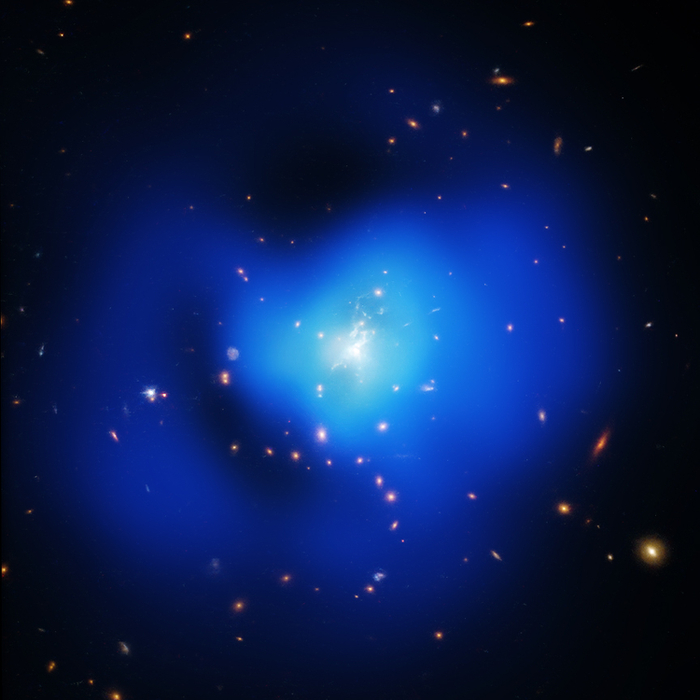
 Credit: X-ray: NASA/CXC/MIT/M.McDonald et al; Optical: NASA/STScI
Credit: X-ray: NASA/CXC/MIT/M.McDonald et al; Optical: NASA/STScI
Schizoid Phoenix
Galaxy clusters are among the largest gravitationally-bound objects that have yet been identified. These enormous objects (the building blocks of our "cosmic web") are held together by the gravity of mysterious dark matter. In addition to the dark matter, these structures contain large amounts of normal matter in the form of stars and hot gas, which, unlike dark matter, radiates electromagnetic waves when disturbed so we can see it. The best way to see galaxy clusters is in the X-ray part of the electromagnetic spectrum, since most of the normal matter associated with most clusters exists at enormously high temperatures producing high-energy X-rays. As shown above in the composite image of the so-called Phoenix Cluster (which lies in the Phoenix constellation in the southern hemisphere), individual galaxies making up the cluster (as seen best via the optical starlight they produce, as shown here in a Hubble Space Telescope optical observation) are embedded within a large pool of X-ray emitting gas (which glows blue in this false-color image taken by the Chandra X-ray Observatory). The hot, X-ray emitting gas is not uniform; large cavities (mostly devoid of X-ray emission) can be seen in the Chandra image. These cavities are believed to have been produced by the outcry of a supermassive black hole at the center of one of the cluster galaxies. This black hole seems to schizophrenically switch between a "quasar-like" behavior (where most of the energy comes out in the form of radiation) and a "radio-galaxy-like" behavior (where much of the energy is carried by the motion of particles accelerated in narrow beams emanating from the black hole). These jets may have created the X-ray voids, but also may have helped spark starbirth along filaments of shocked gas surrounding the cavities.
Published: November 2, 2015
<
HEA Dictionary ● Archive
● Search HEAPOW
● Other Languages
● HEAPOW on Facebook
● Download all Images
● Education ● HEAD
>

Each week the HEASARC
brings you new, exciting and beautiful images from X-ray and Gamma ray
astronomy. Check back each week and be sure to check out the HEAPOW archive!
Page Author: Dr. Michael F. Corcoran
Last modified Monday, 26-Feb-2024 17:36:13 EST


